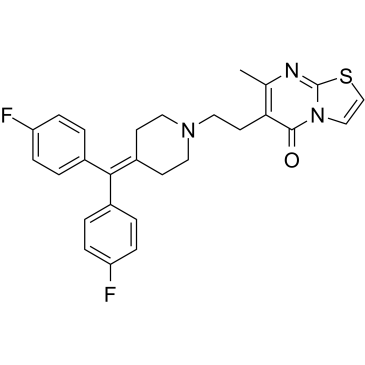Ritanserin

Ritanserin structure
|
Common Name | Ritanserin | ||
|---|---|---|---|---|
| CAS Number | 87051-43-2 | Molecular Weight | 477.56900 | |
| Density | 1.3g/cm3 | Boiling Point | 618.7ºC at 760 mmHg | |
| Molecular Formula | C27H25F2N3OS | Melting Point | N/A | |
| MSDS | Chinese USA | Flash Point | 328ºC | |
| Symbol |

GHS07 |
Signal Word | Warning | |
|
Chemical genetics reveals a complex functional ground state of neural stem cells.
Nat. Chem. Biol. 3(5) , 268-273, (2007) The identification of self-renewing and multipotent neural stem cells (NSCs) in the mammalian brain holds promise for the treatment of neurological diseases and has yielded new insight into brain cancer. However, the complete repertoire of signaling pathways ... |
|
|
Prediction and identification of drug interactions with the human ATP-binding cassette transporter multidrug-resistance associated protein 2 (MRP2; ABCC2).
J. Med. Chem. 51 , 3275-87, (2008) The chemical space of registered oral drugs was explored for inhibitors of the human multidrug-resistance associated protein 2 (MRP2; ABCC2), using a data set of 191 structurally diverse drugs and drug-like compounds. The data set included a new reference set... |
|
|
Genetic mapping of targets mediating differential chemical phenotypes in Plasmodium falciparum.
Nat. Chem. Biol. 5 , 765-71, (2009) Studies of gene function and molecular mechanisms in Plasmodium falciparum are hampered by difficulties in characterizing and measuring phenotypic differences between individual parasites. We screened seven parasite lines for differences in responses to 1,279... |
|
|
Pharmacological evidence that 5-HT1D activation induces renal vasodilation by NO pathway in rats.
Clin. Exp. Pharmacol. Physiol. 42 , 640-7, (2015) 5-HT is a powerful vasoconstrictor substance in renal vasculature (mainly by 5-HT₂ activation). Nevertheless, 5-HT is notable for its dual cardiovascular effects, producing both vasodilator and vasoconstrictor actions. This study aimed to investigate whether,... |
|
|
Identification of "toxicophoric" features for predicting drug-induced QT interval prolongation.
Eur. J. Med. Chem. 43 , 2479-88, (2008) Drugs delaying cardiac repolarization by blockade of hERG K(+) channel generally prolong the QT interval of the electrocardiogram, an effect regarded as a cardiac risk factor with the potential to cause 'torsade des pointes'-type arrhythmias in humans. The pr... |
|
|
Identification of new functional inhibitors of acid sphingomyelinase using a structure-property-activity relation model.
J. Med. Chem. 51 , 219-37, (2008) Some organic weak bases induce a detachment from inner lysosomal membranes and subsequent inactivation of acid sphingomyelinase (ASM) and thus work as functional ASM inhibitors. The aim of the present investigation was to develop a structure-property-activity... |
|
|
Vasoconstrictor and vasodilator responses to tryptamine of rat-isolated perfused mesentery: comparison with tyramine and β-phenylethylamine.
Br. J. Pharmacol. 165(7) , 2191-202, (2012) Tryptamine increases blood pressure by vasoconstriction, but little is known about its actions on the mesentery, in particular the resistance arteries. Tryptamine interacts with trace amine-associated receptors (TAARs) and because of its structural similarity... |
|
|
A pharmacophore hypothesis for P-glycoprotein substrate recognition using GRIND-based 3D-QSAR.
J. Med. Chem. 48 , 2927-35, (2005) Trying to understand the complex interactions that substrates and inhibitors have with the efflux transporter P-glycoprotein has been the subject of various publications. In this work, we have confined our study to substrates by picking a diverse set of 129 c... |
|
|
Serotonergic and dopaminergic distinctions in the behavioral pharmacology of (±)-1-(2,5-dimethoxy-4-iodophenyl)-2-aminopropane (DOI) and lysergic acid diethylamide (LSD).
Pharmacol. Biochem. Behav. 101(1) , 69-76, (2012) After decades of social stigma, hallucinogens have reappeared in the clinical literature demonstrating unique benefits in medicine. The precise behavioral pharmacology of these compounds remains unclear, however.Two commonly studied hallucinogens, (±)-1-(2,5-... |
|
|
5-HT2A receptor antagonists inhibit hepatic stellate cell activation and facilitate apoptosis.
Liver Int. 33(4) , 535-43, (2013) 5-hydroxytryptamine (5-HT) receptors are upregulated in activated hepatic stellate cells (HSCs), and are therefore thought to play an important role in their activation.The aim of this study was to determine whether 5-HT2A receptor antagonists affect the acti... |